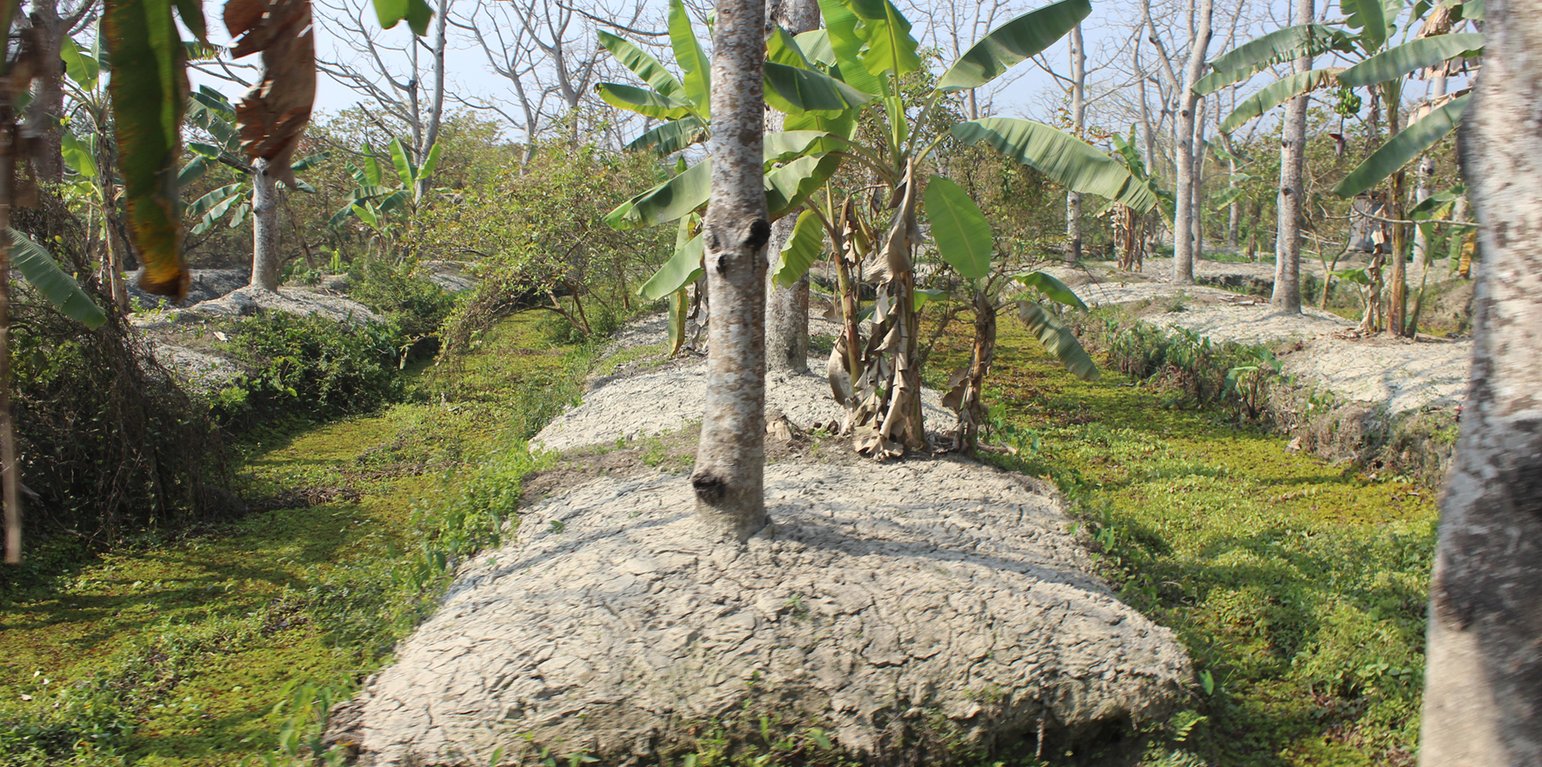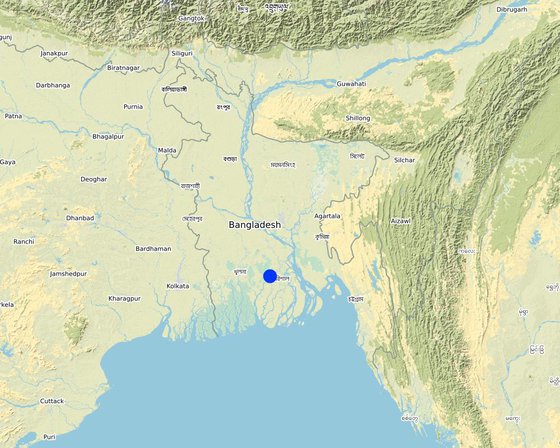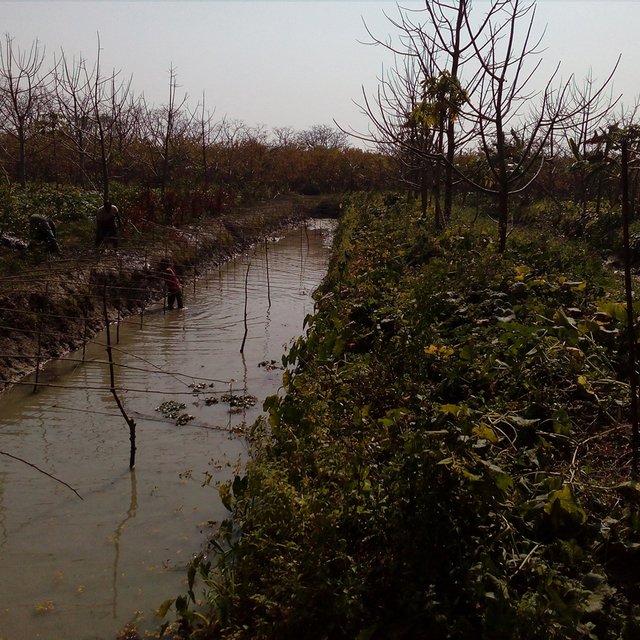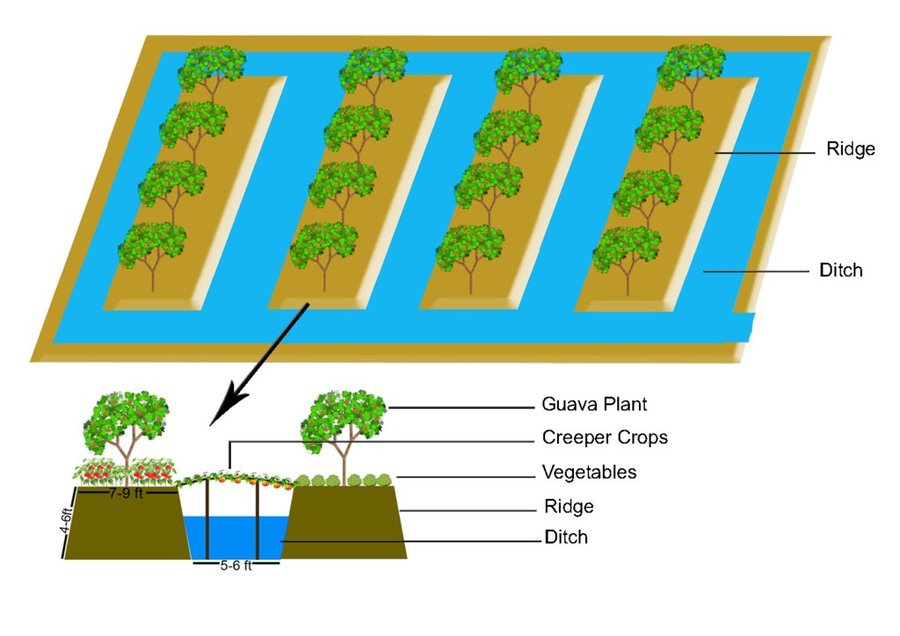



The technology of marshy land convert into ridge and ditch was taken by a community of southern of Bangladesh in order to make that area productive. Long year ago a continuous marshy land covered most of the area of southern Bangladesh like Pirjpur, Jhalokath. This area was flooded more than 9 month and remain perennial wet, that were totally unproductive. So, that technology not only increases agricultural production or economical benefits but also creates a green belt by developing agro-forest. The technology consists of ridge and ditch area. Ridges are elevated beds - land which is 4-6 feet high from surface and 7-9 feet wide. Length of each bed is variable according to size of the land. And ditches are canals - areas that are 5-6 feet wide and deeper than the normal surface area.
At initial stage elevated areas are not strong enough to start cultivating trees like guava, hug plum or other fruit plants. So they use it for nursery of diversified plants, fruit trees such as Banana and Papaya, vegetables, preparation of seedling sapling or as seedbed (rice). Management practices are running every year to develop the ridges and make them strong. Land users are putting soil/muck from the ditches on the ridges to make them higher and to give better protection from flooding water, to increase the fertility, to conserve moisture and reserve organic matter. Though eroded soil and other plant residues are accumulated in the ditches so ultimately they return over the ridge surface. Land become suitable after 4-5 year for planting various trees like guava hog plum, plums, lemons, Areca nuts and various timber producing tress like Teak (Tectona grandis), Mahogany (Swietenia mahagoni). Approximately 7 – 8 year after fruit trees are become appropriate and the physical and biological conditions of the sites have improved. Then land user start to cultivate various vegetables and other agricultural practices. Furthermore, sometime users set up a platform for creeper crops on the canal which works as support for Pumpkins and gourds. Trees and vegetables are irrigated from ditch/canal where water is reserve over the year, even in dry season if necessary. As a result of growing biomass, land degradation from the site has reduced and the fertility of the soil has increased. When fruit trees have reached its harvesting stage, the land users collect fruits for sale with expected income of about 1000USD. Vegetable also provide more than 500USD benefit from each site every year. Approximately 25 years after Mahogany, Teak, and other timber producing trees are getting mature and reach their harvesting stage. Land user cut the trees for selling with expected income of about 10000 USD from each site and size of approximately one hectare.
The technology is working well and is easily manageable by the land users. Nowadays not only farmers but also a large portion of population are interacting with that technology and their lifestyle have changed. Many people are also working to manufacture initial nursery products like seedling bag, earthen pot, creeping materials like bamboo, string, yarn, net, seedling and other material for preparing plant nursery, fruit garden, mixed agro-forest etc. Other people work to transport product from the area to the consumers and some people work to manufacture vehicles like boats, local vans etc. Also locale communities developed the largest floating market of Bangladesh.
The farmers are applying the technology without any extra financial support. According to the land users, they estimate about 200 – 300 family which have applied the technology. Approximately 350 person-day/ha were employed for construction and 50 person – day/ha sufficient for yearly maintenance work. 1600 USD was spending on the construction and most of the cost covered by owner. Farmers have faced some drawback such as undeveloped communication infrastructure and insufficiently developed market places. On the other hand, if they get support from government and related authority, this technology even become more beneficial for them.

Местоположение: Barisal, Atghar Kuriana Union, Swarupkati, Pirojpur, Бангладеш
Число исследованных участков, где применяется Технология: 10-100 участков
Пространственное распространение Технологии: равномерно-однородное применение на определенной площади (approx. 10-100 км2)
На постоянно охраняемой территории?:
Продолжительность применения Технологии: 10-50 лет назад
Тип внедрения/ применения








| Опишите затраты | Единица | Количество | Затраты на единицу (Доллары США) | Общая стоимость на единицу (Доллары США) | % затрат, оплаченных землепользователями |
| Оплата труда | |||||
| skilled labor | person-days | 300,0 | 5,0 | 1500,0 | 100,0 |
| Посадочный материал | |||||
| seedling (fruit trees) | piece | 500,0 | 0,1 | 50,0 | 100,0 |
| seedling (timber producing trees) | piece | 300,0 | 0,1 | 30,0 | 100,0 |
| Другие | |||||
| seedling bag | 1000,0 | 0,01 | 10,0 | 100,0 | |
| earthen pot | 1000,0 | 0,01 | 10,0 | 100,0 | |
| Общая стоимость запуска Технологии | 1'600.0 | ||||
| Общие затраты на создание Технологии в долларах США | 1'600.0 | ||||
| Опишите затраты | Единица | Количество | Затраты на единицу (Доллары США) | Общая стоимость на единицу (Доллары США) | % затрат, оплаченных землепользователями |
| Оплата труда | |||||
| skilled labor | person-days | 50,0 | 5,0 | 250,0 | 100,0 |
| Посадочный материал | |||||
| seedling vegetable ( e.g gourd) | pieces | 250,0 | 0,05 | 12,5 | 100,0 |
| Строительные материалы | |||||
| bamboo | pieces | 50,0 | 1,0 | 50,0 | 100,0 |
| string, ropes | piece | 1,0 | 5,0 | 5,0 | 100,0 |
| Общая стоимость поддержания Технологии | 317.5 | ||||
| Общие затраты на поддержание Технологии в долларах США | 317.5 | ||||
bare land become productive
organic materials are mainly used
vegetable and fruit resides can use as animal food
timber trees not only fill local demand but also supply in many area of Bangladesh
Crop failure by flooding is protected
Here produce timber, fruit, vegetable, seedling sapling etc
production area remarkably increase
Very easy and local farmers manage it easily.
Water is available even in dry season
ditch contain enough water in available condition for plant
Peoples not only depend on agriculture.
It reduces the economic disparities as it opens new working places.
Net yearly production of food increases.
People get proper nutrient from fruits and vegetable, which are totally chemical free
not only men but also women are work on site. normally land users family members are always help them every way
Total amount of water is reduced.
Good quality water found in all seasons.
Drainage condition of cultivated ridge area is very good
Vegetative cover reduces the total evaporation .
Yearly management practice helps to increase the soil moisture.
Annual and perennial crops cover the area.
Plant residue.
Release reserved carbon from muck.
A bare land convert into vegetative cover
Variety among plants and crops is seem.
The trees serve as nesting habitat
ridges are free from flood
water reserved in ditch in dry season
large vegetation consume huge amount of carbon dioxide and greenhouse gases